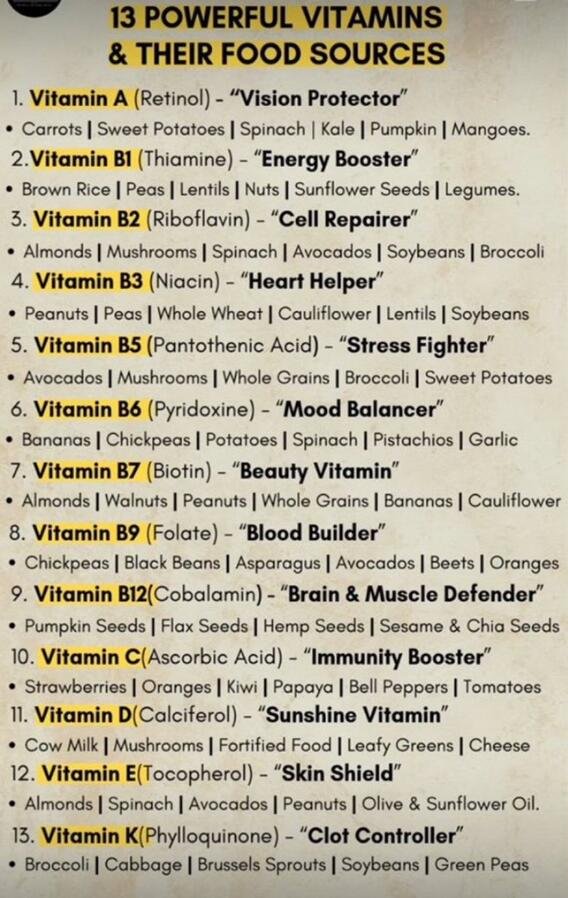13 Essential Vitamins and Their Powerful Benefits
Discover the vital nutrients your body needs and the best food sources to obtain them naturally

In our fast-paced world, maintaining optimal health requires understanding the essential vitamins our bodies need to function at their best. This comprehensive guide explores 13 crucial vitamins, their unique benefits, and the delicious foods that can help you meet your daily requirements naturally.
Vitamin A (Retinol)
“Vision Protector”
Vitamin A plays a critical role in maintaining vision, supporting immune function, and ensuring proper organ function. It’s particularly important for night vision and the health of your retina.
Top Food Sources:
Vitamin B1 (Thiamine)
“Energy Booster”
Thiamine helps convert nutrients into energy and is essential for glucose metabolism. It plays a key role in nerve, muscle, and heart function.
Top Food Sources:
Vitamin B2 (Riboflavin)
“Cell Repairer”
Riboflavin is crucial for energy production, cellular function, and metabolism. It also acts as an antioxidant, fighting free radicals in the body.
Top Food Sources:
Vitamin B3 (Niacin)
“Heart Helper”
Niacin helps maintain healthy cholesterol levels, supports brain function, and aids in DNA repair. It’s also involved in over 400 biochemical reactions in your body.
Top Food Sources:
Vitamin B5 (Pantothenic Acid)
“Stress Fighter”
This vitamin helps produce stress and sex hormones in the adrenal glands. It’s essential for synthesizing coenzyme A, which is involved in fatty acid metabolism.
Top Food Sources:
Vitamin B6 (Pyridoxine)
“Mood Balancer”
Vitamin B6 is involved in neurotransmitter synthesis, helping regulate mood and sleep patterns. It also plays a role in cognitive development and immune function.
Top Food Sources:
Vitamin B7 (Biotin)
“Beauty Vitamin”
Biotin is famous for promoting healthy hair, skin, and nails. It also helps convert food into energy and plays a role in gene regulation.
Top Food Sources:
Vitamin B9 (Folate)
“Blood Builder”
Folate is essential for DNA synthesis and red blood cell formation. It’s particularly crucial during pregnancy for proper fetal development.
Top Food Sources:
Vitamin B12 (Cobalamin)
“Brain & Muscle Defender”
Vitamin B12 is vital for neurological function, DNA production, and red blood cell development. It helps maintain energy levels and supports muscle function.
Top Food Sources:
Vitamin C (Ascorbic Acid)
“Immunity Booster”
This powerful antioxidant supports the immune system, aids in collagen production for skin health, and enhances iron absorption from plant-based foods.
Top Food Sources:
Vitamin D (Calciferol)
“Sunshine Vitamin”
Vitamin D promotes calcium absorption for strong bones, modulates cell growth, and supports immune and neuromuscular function. The body can produce it with sun exposure.
Top Food Sources:
Vitamin E (Tocopherol)
“Skin Shield”
This fat-soluble antioxidant protects cells from damage, supports immune function, and helps keep skin healthy by fighting free radicals.
Top Food Sources:
Vitamin K (Phylloquinone)
“Clot Controller”
Vitamin K is essential for blood clotting and bone metabolism. It activates proteins that help with blood coagulation and bone mineralization.
Top Food Sources:
The Comprehensive Benefits of Proper Vitamin Intake
Enhanced Immune Function
Vitamins A, C, D, and several B vitamins play crucial roles in maintaining a robust immune system. They help produce white blood cells, act as antioxidants, and support the body’s natural defense mechanisms against pathogens.
Improved Energy Levels
B-complex vitamins are essential for converting dietary nutrients into usable energy. Thiamine (B1), riboflavin (B2), niacin (B3), and pantothenic acid (B5) are particularly important for metabolic processes that generate cellular energy.
Cognitive Health Support
Several vitamins, including B6, B12, and folate, are vital for brain function. They help produce neurotransmitters, maintain myelin sheaths around nerves, and may reduce the risk of cognitive decline as we age.
Cardiovascular Protection
Vitamins like B3 (niacin), B6, B12, folate, and E contribute to heart health by helping regulate homocysteine levels, supporting healthy cholesterol profiles, and preventing oxidative damage to blood vessels.
Healthy Skin, Hair, and Nails
Vitamins A, C, E, and biotin (B7) are particularly important for maintaining healthy skin, promoting collagen production, protecting against UV damage, and supporting strong hair and nails.
Bone Strength and Development
Vitamins D and K work synergistically with calcium to build and maintain strong bones. Vitamin D enhances calcium absorption, while vitamin K helps direct calcium to bones rather than soft tissues.
Tips for Maximizing Vitamin Absorption
1. Combine fat-soluble vitamins with healthy fats: Vitamins A, D, E, and K are better absorbed when consumed with dietary fats like olive oil, avocados, or nuts.
2. Eat a variety of colorful fruits and vegetables: Different colors often indicate different nutrient profiles, ensuring you get a broad spectrum of vitamins.
3. Consider cooking methods: Some vitamins (like vitamin C) are sensitive to heat, while others (like lycopene in tomatoes) become more bioavailable when cooked.
4. Be mindful of interactions: Some nutrients compete for absorption (like iron and calcium), while others enhance each other (like vitamin C and iron).
5. Get sunlight exposure: Your skin can produce vitamin D when exposed to sunlight, but balance this with proper sun protection.

